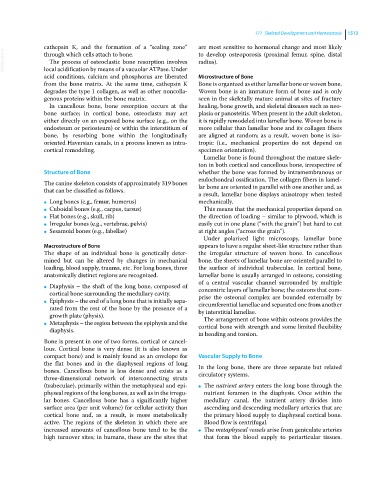Page 1575 - Clinical Small Animal Internal Medicine
P. 1575
171 Skeletal Development and Homeostasis 1513
cathepsin K, and the formation of a “sealing zone” are most sensitive to hormonal change and most likely
VetBooks.ir through which cells attach to bone. to develop osteoporosis (proximal femur, spine, distal
radius).
The process of osteoclastic bone resorption involves
local acidification by means of a vacuolar ATPase. Under
acid conditions, calcium and phosphorus are liberated Microstructure of Bone
from the bone matrix. At the same time, cathepsin K Bone is organized as either lamellar bone or woven bone.
degrades the type 1 collagen, as well as other noncolla- Woven bone is an immature form of bone and is only
genous proteins within the bone matrix. seen in the skeletally mature animal at sites of fracture
In cancellous bone, bone resorption occurs at the healing, bone growth, and skeletal diseases such as neo-
bone surface; in cortical bone, osteoclasts may act plasia or panosteitis. When present in the adult skeleton,
either directly on an exposed bone surface (e.g., on the it is rapidly remodeled into lamellar bone. Woven bone is
endosteum or periosteum) or within the interstitium of more cellular than lamellar bone and its collagen fibers
bone, by resorbing bone within the longitudinally are aligned at random; as a result, woven bone is iso-
oriented Haversian canals, in a process known as intra- tropic (i.e., mechanical properties do not depend on
cortical remodeling. specimen orientation).
Lamellar bone is found throughout the mature skele-
ton in both cortical and cancellous bone, irrespective of
Structure of Bone whether the bone was formed by intramembranous or
endochondral ossification. The collagen fibers in lamel-
The canine skeleton consists of approximately 319 bones lar bone are oriented in parallel with one another and, as
that can be classified as follows.
a result, lamellar bone displays anisotropy when tested
Long bones (e.g., femur, humerus) mechanically.
●
Cuboidal bones (e.g., carpus, tarsus) This means that the mechanical properties depend on
●
Flat bones (e.g., skull, rib) the direction of loading – similar to plywood, which is
●
Irregular bones (e.g., vertebrae, pelvis) easily cut in one plane (“with the grain”) but hard to cut
●
Sesamoid bones (e.g., fabellae) at right angles (“across the grain”).
●
Under polarized light microscopy, lamellar bone
Macrostructure of Bone appears to have a regular sheet‐like structure rather than
The shape of an individual bone is genetically deter- the irregular structure of woven bone. In cancellous
mined but can be altered by changes in mechanical bone, the sheets of lamellar bone are oriented parallel to
loading, blood supply, trauma, etc. For long bones, three the surface of individual trabeculae. In cortical bone,
anatomically distinct regions are recognized. lamellar bone is usually arranged in osteons, consisting
of a central vascular channel surrounded by multiple
Diaphysis – the shaft of the long bone, composed of
● concentric layers of lamellar bone; the osteons that com-
cortical bone surrounding the medullary cavity.
Epiphysis – the end of a long bone that is initially sepa- prise the osteonal complex are bounded externally by
● circumferential lamellae and separated one from another
rated from the rest of the bone by the presence of a by interstitial lamellae.
growth plate (physis).
Metaphysis – the region between the epiphysis and the The arrangement of bone within osteons provides the
● cortical bone with strength and some limited flexibility
diaphysis.
in bending and torsion.
Bone is present in one of two forms, cortical or cancel-
lous. Cortical bone is very dense (it is also known as
compact bone) and is mainly found as an envelope for Vascular Supply to Bone
the flat bones and in the diaphyseal regions of long In the long bone, there are three separate but related
bones. Cancellous bone is less dense and exists as a circulatory systems.
three‐dimensional network of interconnecting struts
(trabeculae), primarily within the metaphyseal and epi- ● The nutrient artery enters the long bone through the
physeal regions of the long bones, as well as in the irregu- nutrient foramen in the diaphysis. Once within the
lar bones. Cancellous bone has a significantly higher medullary canal, the nutrient artery divides into
surface area (per unit volume) for cellular activity than ascending and descending medullary arteries that are
cortical bone and, as a result, is more metabolically the primary blood supply to diaphyseal cortical bone.
active. The regions of the skeleton in which there are Blood flow is centrifugal.
increased amounts of cancellous bone tend to be the ● The metaphyseal vessels arise from geniculate arteries
high turnover sites; in humans, these are the sites that that form the blood supply to periarticular tissues.

